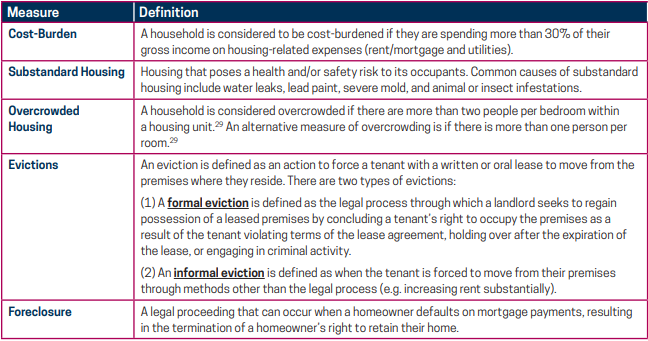Mary Ann Priester
Senior Management Analyst
Mecklenburg County Community Support Services
On December 7, 2023 Mecklenburg County Community Support Services released the 2023 State of Housing Instability & Homelessness (SoHIH) Report. The annual SoHIH continues to provide a single dedicated synthesis of the most recent data on housing instability and
homelessness in Charlotte-Mecklenburg. It provides a knowledge base from which to make informed policy and practice decisions
to facilitate optimized resource allocation and systems of care. The report explores three key components of the housing continuum: housing instability, homelessness, and stable housing. This blog is the first in a series of three blogs will take a deeper dive into each of these components.
This blog post takes a deeper dive into the findings from the first theme: housing instability. It also shares examples of policies and practices that could be implemented locally and nationally to address housing instability.
HOUSING INSTABILITY
Housing instability involves a diverse set of challenges, including struggles with rent payments, overcrowding, and allocating a significant portion of the household’s income to housing-related expenses. Households that dedicate more than 30% of their gross income to housing costs, are considered to be housing cost-burdened. Housing cost burden is a key factor in housing instability.
Housing instability spans the housing continuum from stable housing to homelessness and is influenced by current circumstances and overall housing history. Stably housed low-income households may face housing instability due to job loss, rent increases, medical issues, or unforeseen events. Escalating situations may lead to eviction, impacting future access to permanent, affordable housing.
During times of housing instability, households may seek informal housing assistance from friends, family, churches, or non-profit organizations. This assistance may involve low or no-cost housing arrangements, such as doubling up with friends or family or residing in overcrowded situations. This assistance is often reliant on relationships, and the household may experience temporary or episodic homelessness while moving between temporary accommodations.
The process of moving from homelessness to housing instability and eventual stability is influenced by various internal and external household-specific factors. Households with a history of homelessness are especially at risk of future housing instability.
QUANTIFYING HOUSING INSTABILITY
Housing cost-burden is one of the most common gauges of housing instability. However, while housing cost-burden serves as a metric for quantifying housing instability, it’s essential to recognize its limitations, as it may not encompass all individuals facing housing instability.
Census data, for instance, may not capture households in overcrowded situations, such as those doubling up with family or friends, residing in self-pay hotel or motel arrangements, inhabiting substandard housing, or facing imminent eviction or foreclosure. To obtain a more comprehensive understanding of housing instability, it is crucial to complement housing cost-burden data with additional indicators. Various measures can be employed to effectively quantify housing instability.
WHAT WE KNOW
- The availability of low-cost rentals continues to decrease. 2022 Census data indicates that on 12% of rentals in Mecklenburg County are low cost (<$800 per month).
- Renter cost-burden continues to increase among low and moderate income Mecklenburg County households: Approximately 48% of renters were cost-burdened in Mecklenburg County. The majority of renters earning less than $50k per year are cost burdened in our community.
- Extremely low-income households (<= 30% AMI) are at an especially high risk of experiencing housing cost-burden: There is a 25,442 unit gap in rental units affordable to households at or below 30% AMI. This means at least 25,442 households with income at or below 30% AMI are unable to rent a unit that is affordable to them.
- Eviction cases filed and granted in Mecklenburg County increased in FY23: Eviction filings increased by more than 40% in the last year, resulting in nearly 7,000 additional Mecklenburg households losing their homes and acquiring an eviction record.
APPROACHES TO ADDRESSING HOUSING INSTABILITY
One way to address housing instability is by increasing the availability of affordable housing. An increase in supply will reduce the proportion of households who are housing cost-burdened. Another way to decrease housing stability is to decrease the number of evictions. There are several promising approaches to zoning and land use reform and enhancing tenant protections that have shown early effectiveness in expanding affordable housing and ensuring tenants are able to retain their affordable housing unit.
Zoning and Land Use Reform
Zoning and land use reform is one approach that has shown promise in increasing the quantity of affordable housing in tight housing markets. Grand Rapids, Michigan essentially eliminated single family zoning which allowed by-right multi-family development in mixed-use commercial zones. In addition to banning single-family zoning, the state of Oregon joined 50 other cities across the US in banning parking minimums. Parking minimums not only impact the cost of housing and serve as a barrier to housing development when parking minimums can not be met, but they also take up valuable space where housing could otherwise be built. In addition, in 2016, California passed state-wide legislation which permitted accessory dwelling units (ADUs) on most residential lots. ADUs often qualify as moderate or low-income units and their increase can increase the amount of affordable housing stock. Since the legislation passed, California has seen a 23,000 unit increase in permitted ADUs.
Enhance Tenant Protections
Enhancing tenant protections has the potential to not only decrease evictions for renters but also to increase access to affordable housing. Across the country, there are numerous cities and states who have taken action to enhance tenant protections. Madison, Wisconsin created a Tenant Resource Center that offers housing counseling and mediation services, community resource information, and eviction prevention coordinated entry screening. Toledo, Ohio and Los Angeles and Santa Ana, California have implemented “just cause” eviction policies and ordinances which protect tenants against arbitrary or discriminatory eviction and landlord’s refusal to renew a tenant’s lease. This type of legislation protects tenants from evictions that are no fault of their own and discourages renters from self-eviction.
WHY DOES THIS MATTER
Housing instability impacts individuals, families, and communities. For families and individuals, unstable housing can not only lead to health and mental health problems, it is also often a precursor to homelessness. For communities, high rates of housing instability can increase the demand for social services, put a strain on community resources, and make it more challenging for systems to meet the needs of affected individuals and families.
Addressing housing instability requires comprehensive strategies that encompass affordable housing solutions, supportive services, and policies that promote housing security for all.
The 2023 SoHIH report and all complementary material can be found on the Charlotte-Mecklenburg Housing & Homelessness Dashboard https://mecklenburghousingdata.org/state-of-housing-instability-homelessness-reports/
Stay tuned for future blog posts, which will take a deeper dive into the other key findings from the 2023 SoHIH report.



